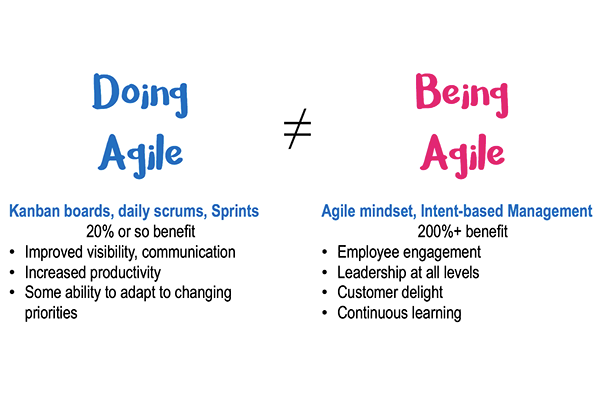Today I was supposed to go to a meetup but did not go. It was a meetup related to Agile and the difference between being agile and doing agile. I had an interesting conversation with my project manager, Steve Howe, who rightly said that being agile is about mindset and not about following a methodology. The conversation took my mind to an event that I attended a few days ago. The topic was “From startup to scale – Measuring value” by Steve Elliot. Steve spoke about agility at the business level. They key was business agility is required to survive in a disrupted world.
In the beginning, I did not understand what he is trying to say when his focus was on large organizations and their problems and the lack of innovation. Then he brought the discussion around the business case and how they take too long to create, to get approved, to get implemented that by the time one has to implement, the world has already moved forward. But then, a stark comparison was made between startup and the large organizations and how it is easier for the smaller companies to innovate. And then I realized and connected the dots.
Why is it difficult for the larger companies to innovate? There are many reasons, ranging from too much process orientation, leadership challenges, bureaucracy, inability to change and so much more. But, how startups innovate? They not only operate with speed and urgency but they identify customer needs and then iterate to find product-market fit. In simple English, startups rapidly and continuously measure value. I also think as startups (or smaller organizations) give importance to continuously measuring value, they are able to not only create incremental value but more importantly let go processes and activities that are not adding value. It is difficult to achieve this at larger organizations as they cannot let go, albeit easily. It is very important to consider this in the context of a number of companies entering and exiting the list of Fortune 500 constantly.
So, what are the best ways to measure value?
While you would have your own answers, here is what I got. Traction, Money, Customer satisfaction, Growth, Interactions and all that can be measurable at the end of the exercise. One amazing term which I learned at the event was “love metric”. That one metric which matters, which can be measured often, a metric that is practical. The event spoke about the cycle of innovation, innovation accounting, taking a lean approach to innovation and a lot more around measuring value and the emphasis on the incremental nature of the process that should be adopted. My focus of this article is not innovation but agility.
That brings me to an amazing connection. It is interesting as to how completely different topics connect with each other. I was just listening to the live video from my friend Sam Brent, and he was talking about three important mindset traits for success in business. One of the key ones which got my attention is to focus on the small incremental wins with a view of long-term success. The key is to do hard work every day and not to do it one day and wait for another six days before moving forward. Again incremental value and the emphasis is on mindset.
Working in the IT industry, I have the benefit of closely looking at different methods followed in the software development methodology. And it is important to understand that these are just templates and one needs to adapt to the method but align it with the culture of the organizations. That is where being agile comes in picture. When one is part of an IT project, which is following the agile method, it is noticed most of the times that the focus is on the process, rather than the output and the value that is generated. One has to understand as to how you need to create an agile environment before one can be agile. And to create an environment one needs to understand the ingredients of the environment, which according to me are more behavioral in nature.
There is a lot which is written recently in the area of being agile and doing agile and one of the articles that I liked was by Jim Ewel. You can find it here. You can see that being agile is related to the basics of organizational behavior rather than just an IT project methodology. It is a cultural argument.
Source of image: www.agilemarketing.net
So, the question that I ask is, are you agile at an individual level, at team level or at an organization level? If you find it difficult to decide, this article on being a superhero by Gartner can help.
One of the organizations that I truly appreciate in their ability to deliver is Air New Zealand. Their manager, Michelle Ross sums up nicely here.
Will be interesting to read your comments and thoughts.



0 Comments
1 Pingback